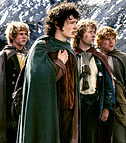
Movie Guru Rating:

Comment
on this review
| |

Jackson shows fellowship to the ring, but it may be nothing more than geek love
by Lee Gardner
The Lord of the Rings is great. Go see it. Now leave me alone.
No, really, it is. As I have told every eager fan who has asked since I attended an advance screening a couple of weeks ago, it is pretty much everything any reasonable fan of J.R.R. Tolkien's much-loved Middle Earth books could hope for, preserving the character and essential details of the first third of the sprawling yarn while motoring along quite efficiently for each of its (nearly) three hours and looking amazing every second of the way. And yet, as the screening recedes into the mists of time, an uncomfortable, nameless feeling stirs in the deepest chambers of my teenage-Tolkien-fan heart. It suspiciously resembles disappointment.
On the surface, there is remarkably little to be disappointed about here. There is an introductory prologue that briefly and painlessly explains the pertinent history of Middle Earth, its evil overlord Sauron, and the diabolical and all-powerful ring he lost and wants back. Then, suddenly, You Are There, watching Gandalf the wizard (Ian McKellen) enter the rolling hills of the Shire to visit half-sized, furry-footed hobbit Bilbo Baggins (Ian Holm) and his nephew Frodo (Elijah Wood), true to Tolkien's prose in every observable detail. As Frodo and hobbit pals Sam, Pippin, and Merry (Sean Astin, Billy Boyd, and Dominic Monaghan, respectively) flee the Shire with the ring, they run smack into one Tolkien icon after another: enigmatic swordsman Aragorn (Viggo Mortensen); elves Arwen (Liv Tyler) and Legolas (Orlando Bloom); dwarf Gimli (John Rhys-Davies, toiling under the movie's lone bad makeup job); sweaty, shifty warrior Boromir (the professionally sweaty and shifty Sean Bean); Saruman the wizard (a magisterially creepy Christopher Lee). If you're a fan of the books, it's a little overwhelming, and the gape-mouthed shock doesn't let up as the film unspools and the sweeping plot that will wend through two more films (to be released in 2002 and 2003) trundles into motion.
Credit for the fact that it moves at all is due director Peter Jackson, of whom I am as much a fan as I ever was of Tolkien's trilogy. As his 1994 classic Heavenly Creatures attests, New Zealander Jackson is a born fabulist and a director capable of making CGI effects seem like an extension of the imagination rather than expensive razzle-dazzle. It's hard to imagine anyone doing a much better job bringing Middle Earth to Middle America.
First, Jackson does no harm to the material. He tempts purist wrath by streamlining the plot a bit (bye-bye Tom Bombadil) and pumping up the romance between Aragorn and Arwen a tad. But the film is generally faithful, resists camp (Jackson indulges himself in but a single anachronistic joke), and even improves the story for the screen by including a number of scenes only discussed in the novel (such as Gandalf and Saruman's wizardly mano-a-mano). And the adaptation more effectively illustrates some of the books' themes, such as the addictive, ruinous temptation the ring's power offers—a temptation only the wisest characters can resist.
Likewise, Jackson's visual approach is comprehensively on target. Thanks to his effortless use of effects, a half-sized Holm and Wood look right at home next to a towering, tottery McKellen, and Sauron's flaming eye isn't anywhere near as corny as it sounds. While the director is smart enough to let the movie magic work for him (CGI fireworks! Gajillions of goblins!), he's also crafty enough to keep things less than perfect. The characters are often muddy and in obvious need of a shower and shampoo, key touches that help keep such outsized characters as McKellen's mercurial Gandalf and Mortensen's conflicted Aragorn in the realm of belief. Beyond the human scale, Lord of the Rings is even more impressive, as Jackson's high-flying camera swoops all over (and under) Middle Earth, adding even more brio to the transitions and action sequences, the best of which hit peaks of über-drama that rival another Ring cycle, Wagner's.
But for all here that is great, doubts creep in. Will viewers who don't carry maps of Middle Earth around in their heads be able to follow the characters' constant travels hither and yon? Will the plot points and characters make as much sense or evoke the same excitement if you haven't been waiting years for them to appear onscreen? ("So what's the deal with this Elrond guy again?") Is Elijah Wood's Frodo, the very heart of the story, just a little bit too blue-eyed-soulless, like a furry-footed version of David the robot boy from A.I.?
In short, so to speak, I find myself wondering if The Lord of the Rings: The Movie has significant appeal for anyone other than fans and 14-year-olds. Jackson has done a stellar job bringing Tolkien's vision to the screen, a wizard-worthy feat indeed. As someone who read and loved those books, that makes me happy. But I suspect that he may have missed a more elusive goal—making a film that can stand on its own, without cult enthusiasm propping it up; a film nonfans could walk into cold and walk out three hours later feeling they spent their time wisely. I couldn't tell you, but I'm dying to find out.

January 3, 2001 * Vol. 12, No. 1
© 2000 Metro Pulse
|